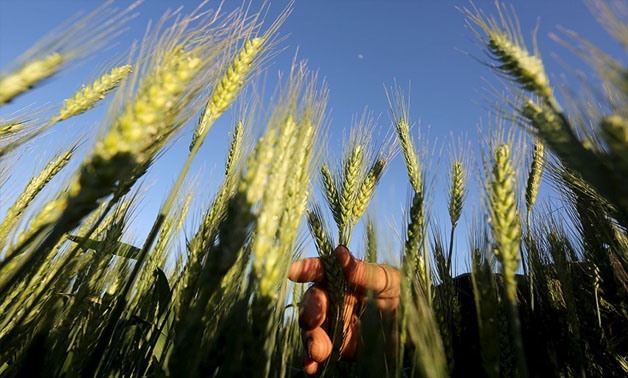
A farmer tends to a wheat farm in the El-Dakahlia governorate, north of Cairo, in February. The government says that last year's wheat crop was much bigger than normal. Many private industry sources say that's not true. REUTERS/Mohamed Abd El Ghany
CAIRO – 13 May 2018: A recent report by the U.S’Foreign Agricultural Service (FAS) in Cairo forecasts Egypt’s wheat production in marketing year (MY) 2018/19 (July-June) to reach 8.45 million metric tons (MMT), up by 4.3 percent compared to marketing year 2017/18.
The forecast is based on an increase in total area harvested reaching 1.32 million hectares. The report is revising upward MY 2017/18 wheat production to 8.45 MMT by 350,000 metric tons (MT) from the United States Department of Agriculture’s (USDA) official estimate of 8.1 million metric tons.
“We are revising upward the wheat area harvested by 60,000 HA from USDA’s official estimate of 1.26 million hectare,” the report said.
It explained that Egyptian wheat production in MY 2017/18 displaced 30,000 hectares of other winter field crops (sugar beet and Egyptian clover or Berseem), as well as 20,000 hectares of winter vegetable crops in Upper Egypt and in the Northern Delta.
The report added that farmers’ profitability rose in tandem with higher government procurement prices paid during the final calendar year 2017 harvest.
As for imports, FAS Cairo forecasts Egyptian wheat imports in MY 2018/19 at 12.5 million metric tons, in line with USDA’s official forecast figure of 12 million metric tons.
The report said that in calendar year 2017 (January-December), imports by the General Authority for Supply Commodities (GASC) reached about 7.53 MMT, up from 4.3 MMT in calendar year 2016.
Imports by the GASC in CY 2017 accounted for 60.2 percent of Egypt’s total wheat imports. Private sector imports reached 4.9 MMT, accounting for 39.8 percent of Egypt’s total wheat imports, data from the report showed.
Concerning wheat consumption, FAS Cairo forecasts Egypt’s total wheat consumption in MY 2018/19 at 20 MMT, up 1.5 percent from the MY 2017/18 estimate. The latter remains unchanged from USDA’s official estimate of 19.7 million metric tons.

Comments
Leave a Comment